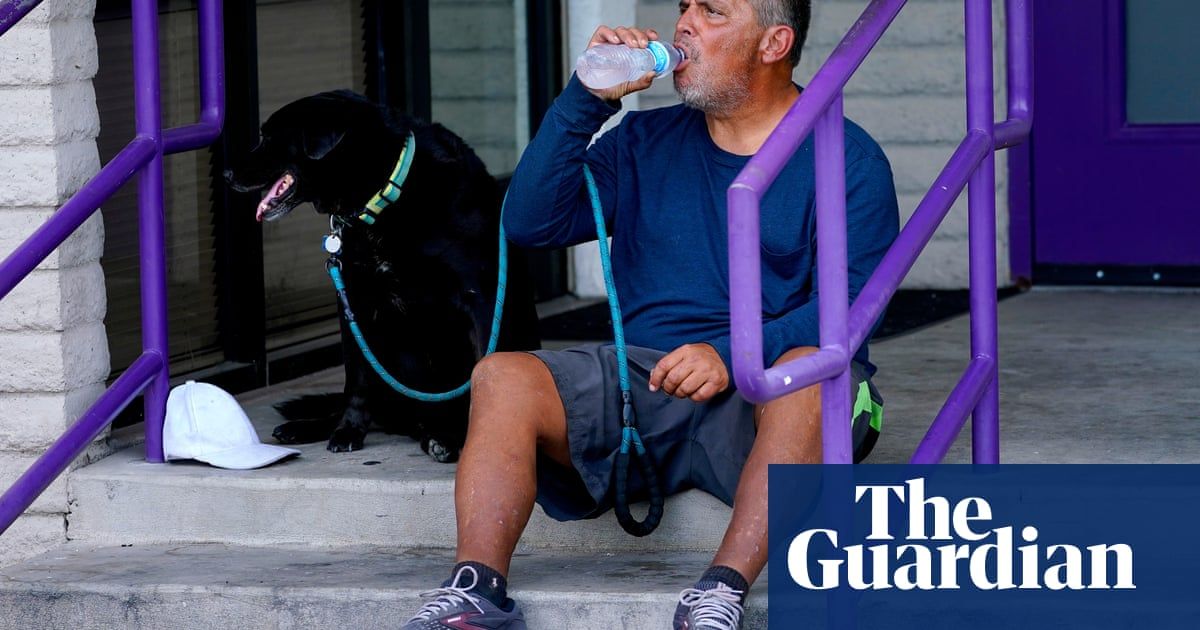Residents of US south-west swelter under record-breaking heatwave
Record-breaking heat is baking the US south-west this week, putting millions under extreme heat warnings as temperatures upwards of 100F (38C) hit Arizona, Nevada, New Mexico and southern California for days on end.
Even desert residents accustomed to scorching summers are feeling the relentless grip of the heat. Phoenix, which was poised to hit a 12th consecutive day of 110F on Tuesday, could see its longest ever heatwave.
The high temperatures in Arizona’s largest city are expected to continue through next week, with the National Weather Service warning it will rival “some of the worst heatwaves this area has ever seen”. The region has not yet seen any monsoon activity, powerful storms that can help offset blazing temperatures and are typical of this time of year.
In Phoenix, Martin Brown and his black labrador, Sammy, escaped the heat on Monday in the lobby of Circle the City, an air-conditioned walk-in health clinic for homeless people that is also a designated hydration station. Anyone can come in, sit, and get bottled water or snacks like a burrito or ramen.
“We’re homeless, so we don’t have a choice. Well, we have a choice: we can sit at the park and swelter in the heat, but no thank you. This is much better,” said Brown, who spends five days a week there.
The heat has made pockets of the desert city feel like ghost towns. A series of sunset concerts was canceled, and covered restaurant patios equipped with cooling misters sit empty. Authorities have also closed some local hiking trails, including Camelback Mountain and Piestewa Peak, for much of the week.
Meanwhile, city officials have advised residents to stay cool, hydrate, and check on neighbors and loved ones, particularly if they live alone.
Water is delivered to ground crew at Sky Harbor international airport on 10 July 10 in Phoenix, Arizona. Photograph: Matt York/AP
The high pressure needed to generate monsoon storms is not in the right position, according to state climatologist Dr Erinanne Saffell, leaving metro Phoenix with below-normal precipitation and dry conditions that facilitate higher temperatures. Some experts also think this year’s heavier snowpack in the west took more energy to melt, prolonging the progression of a summer high-pressure system.
“It just kind of delayed everything,” Saffell said.
Phoenix’s sprawling concrete and pavement further adds to the misery, as sidewalks and buildings bake all day and release accumulated heat slowly overnight. During the current wave, the “low” temps are not dipping below 90F (32.2C).
“Phoenix in the early 1900s would average about five days a year where they had 110 degrees or higher. Now you count the last 10 years, it’s about 27 days a year. That’s five times more,” Saffell said.
Las Vegas could also reach between 110 and 115F this weekend, according to the National Weather Service. Inland areas of southern California are predicted to see conditions peak between 100 and 113F from Friday through Sunday.
In Albuquerque, New Mexico, temperatures were forecast to be between 100 and 103F on Tuesday with a heat advisory in effect all day. City officials warned that the area was experiencing some of its hottest temperatures on record and opened multiple cooling centers.
Like every summer, libraries, churches and other facilities in Phoenix serve as cooling centers or hydration stations for those who need refuge.
Isaiah Castellanos spent Monday morning inside the city library’s downtown branch and said he planned to return after grabbing lunch. A liver transplant recipient, Castellanos said his medications make him sunburn easily. He cannot afford to go to the movies or a museum, so the free public library is his go-to place to escape his under-air-conditioned home.
“It’s quiet. I’ll turn on my music and read a book or watch YouTube with my headphones, but also stay cool,” Castellanos said.
Melody Santiago, who oversees the front office of the Circle the City clinic, said some people are so grateful they return with thank-you cards or cookies. She is certain more will come in over the next week.
“It’s getting really hot, and they have nowhere else to go,” Santiago said.
Source: The Guardian US


